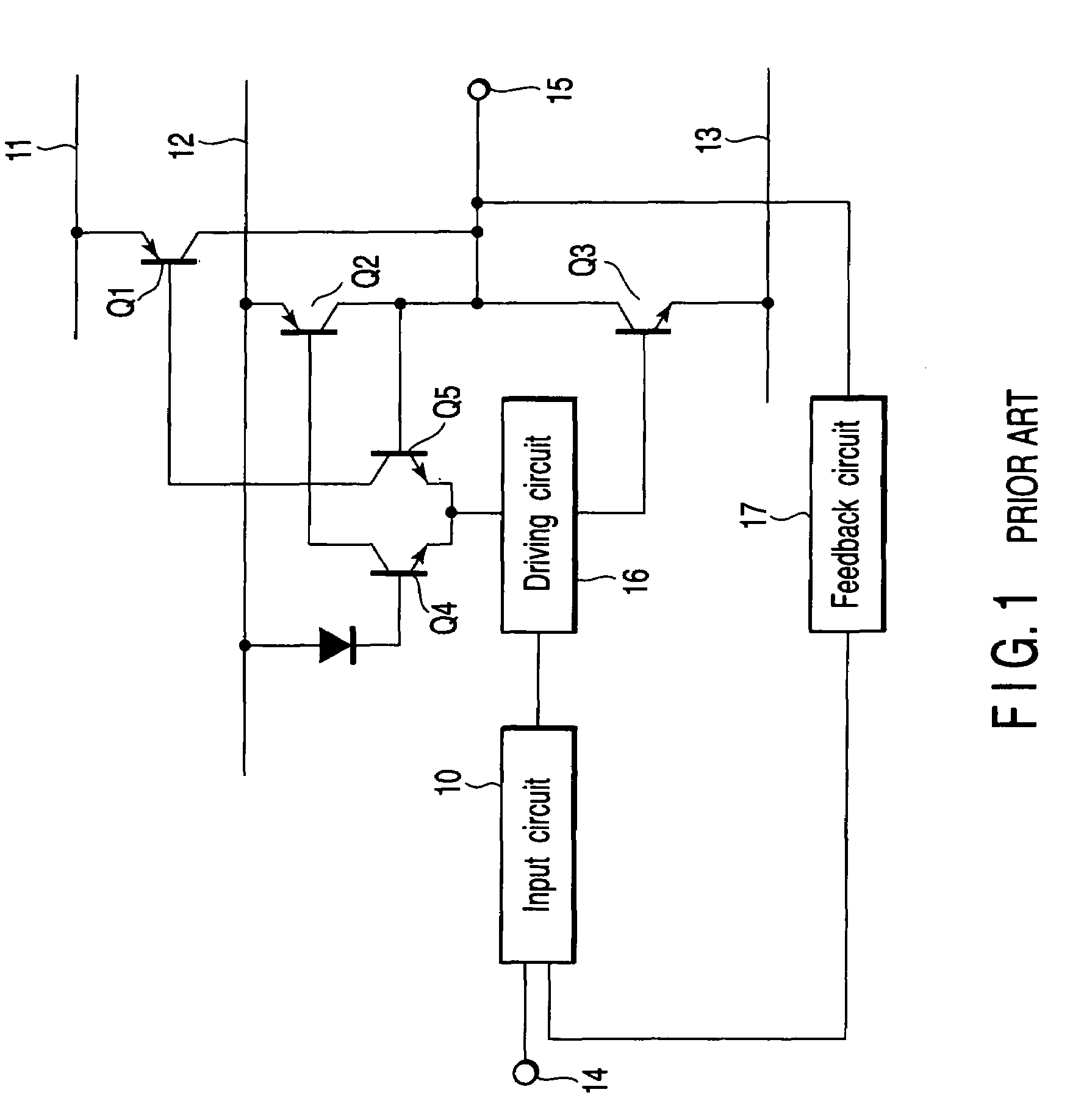Power amplifier
a power amplifier and amplifier technology, applied in the direction of amplifiers, amplifiers with semiconductor devices only, amplifiers with semiconductor devices, etc., can solve the problem of insufficient high efficiency
- Summary
- Abstract
- Description
- Claims
- Application Information
AI Technical Summary
Benefits of technology
Problems solved by technology
Method used
Image
Examples
first embodiment
(First Embodiment)
[0054]FIG. 2 is a circuit diagram (block diagram) that illustrates the basic structure of a power amplifier circuit, which is common to first to fifth embodiments of the present invention. An input circuit 1 receives an input signal from an input terminal and a feedback signal from a feedback circuit 5, amplifies the input signal and feedback signal, and delivers a first or a second control signal to a push-side driving circuit 2 or a pull-side driving circuit 3.
[0055]The push-side driving circuit 2 is supplied with power from a first power supply rail (power supply line) 11, and the pull-side driving circuit 3 is supplied with power from a third power supply rail (power supply line) 13. Normally, the first power supply rail 11 is connected to a power supply (Vcc) of the apparatus, and the third power supply rail 13 is connected to a ground potential (GND). Each of the push-side driving circuit 2 and pull-side driving circuit 3 has three driving signal output termi...
second embodiment
(Second Embodiment)
[0075]FIG. 4 is a circuit diagram of a power amplifier circuit according to a second embodiment of the invention. The second embodiment differs from the first embodiment in that the transistors of the push-side driving circuit 2 are composed of PMOS transistors Ma1, Ma2 and Ma3 and the transistors of the pull-side driving circuit 3 are composed of NMOS transistors Mb1, Mb2 and Mb3. The other parts are common to the first embodiment, and an overlapping description is omitted here.
[0076]The push-side driver transistors Ma1, Ma2 and Ma3 have a gate width / length (W / L) ratio or a gate area ratio of 4:1:2, and the pull-side driver transistors Mb1, Mb2 and Mb3 have a gate width / length (W / L) ratio or a gate area ratio of 1:1:1. Note that W is the gate width and L is the gate length.
[0077]Like the first embodiment, in the no-signal state in which no signal is input to the input terminal, the input circuit 1 is affected by the feedback circuit 5 so that a current of I may f...
third embodiment
(Third Embodiment)
[0082]FIG. 5 is a circuit diagram of a power amplifier circuit according to a third embodiment of the invention. A first output transistor M1 is connected between the first power supply rail 11 and the output terminal 15. A second output transistor M2 is connected between the second power supply rail 12 and the output terminal 15, and a third output transistor M3 is connected between the output terminal 15 and the third power supply rail 13.
[0083]Driver transistors (bipolar transistors) Qa1, Qa2 and Qa3, which are driven by the input circuit 1 and function as the push-side driving circuit 2, have emitter areas with a ratio of 4:1:2, and their emitter resistances Ra1, Ra2 and Ra3 are set at ¼, 1 and ½, respectively. On the other hand, driver transistors (bipolar transistors) Qb1, Qb2 and Qb3, which are driven by the input circuit 1 and function as the pull-side driving circuit, have emitter areas with a ratio of 1:1:1, and their emitter resistances Rb1, Rb2 and Rb3 ...
PUM
 Login to View More
Login to View More Abstract
Description
Claims
Application Information
 Login to View More
Login to View More - R&D
- Intellectual Property
- Life Sciences
- Materials
- Tech Scout
- Unparalleled Data Quality
- Higher Quality Content
- 60% Fewer Hallucinations
Browse by: Latest US Patents, China's latest patents, Technical Efficacy Thesaurus, Application Domain, Technology Topic, Popular Technical Reports.
© 2025 PatSnap. All rights reserved.Legal|Privacy policy|Modern Slavery Act Transparency Statement|Sitemap|About US| Contact US: help@patsnap.com



